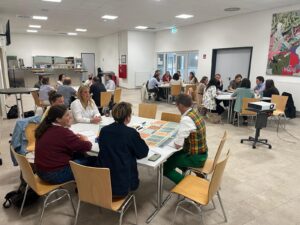What might the ideal 15-minute city in Luxembourg look like? On 19 May 2025, around 30 participants gathered in the Centre Sportif in Niederkorn for the first CIPU workshop of the year to creatively explore this question. Instead of working within today’s limitations, they took a leap into the future – into the fictional city of Duffereschbourg in the year 2045. With maps, markers, and a dose of imagination, they envisioned a city where all daily needs are close by, urban life is vibrant, and people live, work, and move in balance with each other and the environment.
This workshop depicted the second phase in the CIPU’s 2025 process toward urban proximity and everyday urbanity, inspired by the concept of the 15-minute city. More than just collecting ideas, the workshop’s aim was to engage participants in a strategic process to open perspectives and build shared visions that will inform concrete actions in the coming months.
A Workshop Framed by Fiction – Duffereschbourg 2045
The day began with a deep breath and a guided thought experiment. Participants were invited to close their eyes and walk – mentally – through the streets of Duffereschbourg, a fictional city set between Differdange, Dudelange, Esch and Luxembourg City, located along the Alzette River. Once a steel town, Duffereschbourg had evolved into a diverse, green, and tech-driven urban hub.

Groups developing the vision for Duffereschbourg 2045 (Source: Zeyen+Baumann)
This imagined future initiated the development of a vision – a compass to explore the values, qualities, and experiences that could shape Luxembourgish cities in 20 years. The method allowed participants to step beyond everyday constraints and think long-term: What kind of city do we want to live in? What does “urban proximity” feel like, e.g. when accessing locations of our daily needs? And how can mobility, public space, local economy, and social participation be reimagined on a neighbourhood scale?
Phase A: Strategic Visioning through Creative Materials
In the first working phase, participants developed “flyers from the future” – fictive promotional materials showcasing life in Duffereschbourg in 2045. Each group chose at least three themes – mobility, local economy, green infrastructure, social participation, or digital communities – and imagined what their future city stands for in that thematic field.
The flyers included slogans, potential visualisation, citizen or visitor testimonials, and mottos. While encouraging creative thinking, the exercise highlighted common priorities across the groups: accessible local services, a strong community feeling, high-quality public space, and active, sustainable mobility.
Phase B: From Vision to Spatial Translation
With these visions in mind, the participants moved into the second phase: urban spatialisation. Using a blank city map of Duffereschbourg, each group began designing a city where the 15-minute principle could come to life.
Transferring the vision onto a map of Duffereschbourg 2045 (Source: Zeyen+Baumann)
The task required translating their abstract ideas into spatial structures: Where should schools be located? How close are services to residential areas? Where are mobility hubs or green corridors? Again, the group work made visible the tensions and synergies between different priorities – compactness versus greenery, density versus comfort, or innovation versus identity. It revealed how the concept of the 15-minute city, while simple in its promise, becomes complex and context-specific when applied spatially.
A Process, Not a Product
Rather than seeking ready-made solutions, this first workshop was designed for exploration. The CIPU chose to start with fiction after developing a common understanding of the concept with the online lecture series – to loosen constraints, encourage participation, and identify common values. They depict the foundation for the next stages of the CIPU programme, shifting to the application in real cities, testing the measures and dissemination. The entire sequence of events in 2025 follows a successive process (see figure below).
Sequence of CIPU events 2025 (Source: CIPU)
What Comes Next?
The results of Workshop 1 will soon be available on the CIPU website and will feed into Workshop 2 in June. Participants will work with real locations and translate the imagined into the actionable.
As Luxembourg’s municipalities face increasing complexity and changing demand, the idea of the 15-minute city can serve as a shared instrument. It must be contextualised, adapted, and co-created – as this workshop clearly showed. A vision of the ideal 15-minute-city in the future gives orientation for the further steps.
Contact and further information
CIPU – Cellule Nationale d’Information pour la Politique Urbaine: cipu@zeyenbaumann.lu
The documentation of the results will be published soon on www.cipu.lu







